Summer Exhibition 2022
Secret Yeovil
Summer Exhibition 2022 - presented by Yeovil's Virtual Museum
![]()
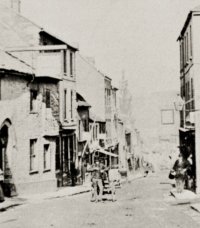 Middle Street, c1875. The three-storey house at left was the home and shop of murderers Robert Slade Colmer and his wife, Jane. |
|
![]()
Introduction
Of course,
very little
about Yeovil's
history actually remains
'secret', but
there is an
awful lot that
is less
well-known. This
exhibition is
therefore an
attempt to
uncover some of
the unfamiliar
facets of
Yeovil’s past,
concerning both
the town itself
and its people.
Much of the
information
included here
comes from my
book 'Secret
Yeovil',
although all
aspects of the
exhibition may
be found in much
greater detail
within Yeovil's
Virtual Museum,
the A-to-Z of
Yeovil's
History, and
hyperlinks are
given within the
text. Enjoy.
![]()
Secrets of the Streets
We begin with some name changes that have occurred to Yeovil's streets
through the
ages. Many name
changes are well
known; for
example Pyt Lane was the original name of Middle Street
probably because of a number of flax pits or tanning pits in the
vicinity.
Brickyard Lane,
with three
brickyards at
one time, became
St Michael's
Avenue and
Grope Lane,
with two
possible origins
(groping one's
way along the
dark, unlit lane
and a more
lascivious
explanation),
became Wine
Street. But
there are
several unusual
name changes
that are
long-forgotten
today.
At one time Yeovil's weekly markets were held in the streets with particular streets known for the livestock or produce being sold.
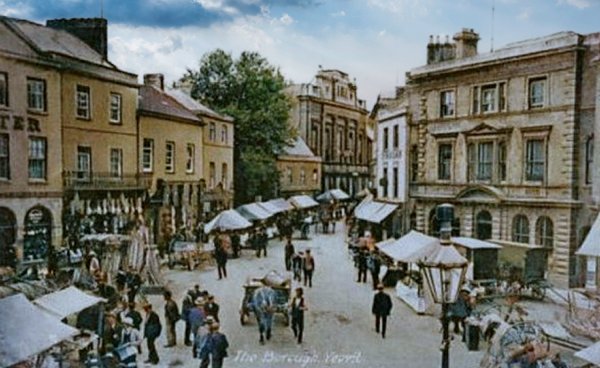
From my
collection. This
colourised photograph
features in my
book 'Secret Yeovil'.
A postcard of about 1905 (this one was posted in 1911) showing the Town Hall beyond the weekly market in the Borough.
 |
The nineteenth century saw a subtle gentrification of parts of Yeovil resulting in some name changes, so Hog Market (by the Three Choughs, seen at left) reverted to Hendford, Cattle Market was renamed Princes Street, Sheep Lane became North Lane (both names being preferable to its earlier sobriquet, Shitt Lane) and Cornmarket once again became Silver Street. It was noted in 1846 that "Some 4,000 sheep and 600 beasts thronged Cattle Market and Sheep Lane".
|
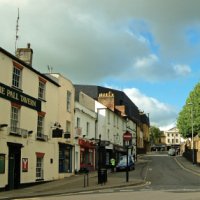 |
Silver Street had been known by several
names; in the 16th century
it was referred to as Stairs Hill, alluding to the steps in the
churchyard
wall.
A road called Silver Street often implies nearby water and, in Yeovil’s
case,
the
Rackel
stream
(now
below ground) created a shallow ford across the road, by the
Pall
Tavern.
In the 12th century,
the road
on the
other
side of
the ford
was
known as
Ford
Street later called Rackleford - the ford across the Rackle. In the 19th century it was called Rotten Row and was a horse market but today it is
known as
Market
Street.
|
In 1825, "the new road belonging to Peter Daniell" was a road which, combined with Park Street running from the east, replaced the circuitous and very steep route of Addlewell Lane and Chant's Path. The new road was originally called New France although after a couple of years the 'New' epithet had worn off and the road became known as France Street. By 1835 it had acquired the name by which it is known today - Brunswick Street.
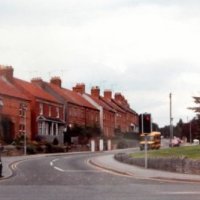 |
Larkhill Lane, seen at left from Preston Road, became today's Larkhill Road but was earlier known, certainly as late as 1841, as Down Lane and beyond the Thorne Lane crossroads it was known as Ashley Lane.
There
was a
John
Sperwe,
or
Sparrow,
whose
will
leaving
lands in
Yeovil,
is dated
1417.
What we
know
today as
Sparrow
Road was
called
Sparrow
Lane
until
the
1840s
but from
the
1850s to
the
1880s it
was
called
Coalpaxy,
or Colpexin,
Lane. |
At one time
there was a
continuous route
from Yeovil to
Ilchester by
ancient
footpaths and
tracks. It
started at
Kingston with
Red Lion Lane,
continued along
Roping Path to
Mudford Road. It
then crossed the
road and entered
a large field
called
Green
Cross, lying
roughly between
the modern
southern
entrance to
Yeovil College
and
Goldcroft.
Green Cross
probably spanned
both sides of
Mudford Road,
albeit chiefly
to the west. As
it continued,
the footpath was
known as
Hillon
Path and is
referred to in
the
Terrier of
1589.
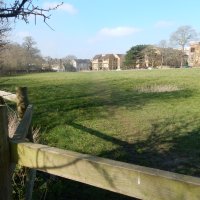 |
Penn Way was a lane across the lower western slopes of present day Wyndham Hill, seen at left. Penn Way commenced close to the Newton Road site of the later Penstyle Turnpike gatehouse, (today the site of Ivel Court) apparently as a lane, little better than a track, for a short distance before continuing as a footpath, roughly following along the route of today's Railway Walk, to Yeovil Bridge. Penn Way even had a pub - The Sun. |
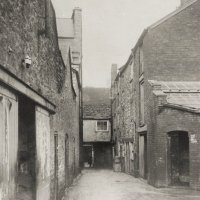 |
George
Court
was
little
more
than an
alleyway
linking
High
Street
with
South
Street
and
flanked
with
ruinous
buildings
and had
something
of an
ill
reputation.
In
keeping
with
other
'courts'
of
all-but
slum
housing
in
Yeovil,
George
Court
was
usually
home to
several
poor
families
at any
one
time.
George
Court
also had
stables,
so with
them,
the meat
market
and the
cheese
market
along
the
western
side,
the air
in the
narrow
Court
must
have
been
quite
'special'.
|
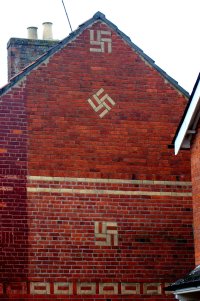 |
Colloquially
known as
the Swastika
Terraces,
two
un-named
terraces
of
houses
in Grass
Royal
feature
decorative
swastika
patterns
formed
in
cream-coloured
brickwork.
This
contrasts
with the
local
red
Yeovil
bricks
that
were
almost
certainly
made
just
around
the
corner
at the
brickworks
in
Brickyard
Lane,
today's
St
Michael's
Avenue.
|
![]()
Secrets of St John's church
The Iron Cross
In 1415, the year of Henry V’s victory over the French at Agincourt, the
king personally
laid the
foundation stone
of the Convent
of Syon at
Isleworth,
Middlesex. In
1420 the Abbess
and 35 nuns took
possession of
the convent,
properly known
as ‘The
Monastery of St
Saviour and St
Bridget of Syon
of the Order of
St Augustine’.
It was built as
part of 'The
King's Great
Work'.
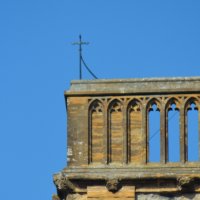 |
In order to part-support the convent, Henry granted them the Yeovil rectory of St John the Baptist and Lordship of the Borough of Yeovil together with ‘two acres of land in Huish and a portion in Martock’. For the next 114 years, until the Dissolution of the Monasteries in 1534 by Henry VIII, Yeovil came under the jurisdiction of the Abbess and was administered locally by a resident bailiff in conjunction with the Portreeve and Burgesses. |
There is a little-known small iron cross fixed to the eastern parapet of St John's church tower indicating that the church was exempt from taxation while the borough was held by the Convent of Syon between 1420 and 1534.
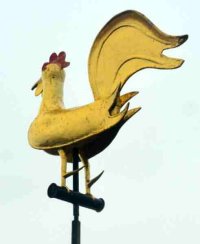 |
The
Weathercock When the present weathercock was erected in 1745 The Churchwardens' Accounts recorded that the cost was £3 5s 6d (£1 4s 0d for supply and a further £2 1s 6d for gilding and erection - £3 5s 6d at today's price, but around £550 at today's value). |
The Lectern
A lectern (from the Latin lectus,
"to
read")
is a
reading
desk
with a
slanted
top,
placed
on a
stand,
on which
books or
documents
are
placed
as
support
for
reading
aloud,
as in a
scripture
reading,
lecture,
or
sermon.
St
John's
double-desk
lectern, is referred to in old records, such as the
Churchwardens'
Accounts,
as the 'Dext'.
It is
inscribed
in Latin
and is
complete
with a
picture
(later
defaced)
of the
donor
monk,
Brother
Martin
Forester.
The
Latin
inscription,
in Blackletter,
reads -
"Precibus
nunc
precor
cernuis
hinc eya
rogate.
Frater
Martinus
Forester
vita
vigiletque
beate."
This
roughly
translates
as "I
pray you
now
offer
humble
prayers
so that
Brother
Martin
Forester
may
awaken
in the
blessed
afterlife".
The lectern was acquired by the Churchwardens of St John's, John Hacker
and John
Parker,
in 1541
at a
cost of
£3
(about
£16,000
at
today's
value).
St John's church houses an exceptional and rare English lectern which
dates to about
1450 - just a
few decades
after the church
itself was
built. It is one
of only four of
its type in the
entire country
and is the sole
example still in
a parish church
(the others are
at Eton College,
Berkshire,
Merton College,
Oxford and
King's College,
Cambridge).
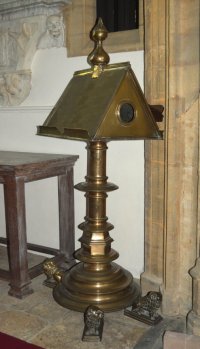
The Bosses and
'African' Masks
People rarely look upwards inside buildings, which is a pity as much is
missed -
especially in St
John's church
where there is a
wealth of
medieval carved
roof bosses in
the nave,
chancel and
aisles. You will
need a pair of
binoculars to
see them
properly. The
bosses are
thought to date
to 1404-5 when
the construction
of the church
was nearing
completion.
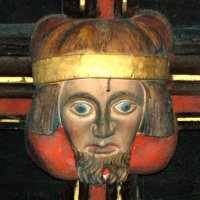 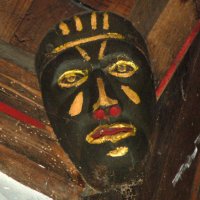 |
There are many bosses featuring flowers, foliage or abstract designs but a woman’s head features, as do the head of a man and the head of Christ. One boss has four faces and another is of a horned man – perhaps Satan looking down on the congregation? At left is the face of Robert de Sambourne, builder of today's St John's church. The painting seen on the bosses today is, of course, modern. Whether or not the bosses were painted originally is not known but unlikely, certainly not in the bright colours seen today.
Additionally, there are roof bosses in the form of grotesque 'African'
masks,
numbering
about 30
in all
and
located
primarily
in the
north
and
south
aisles.
The
dating
above is
thought
to be
also
applicable
to the
'African'
bosses.
Probably
unique,
the
origins
of these
strange
bosses
are
unknown. |
The Black Halos
The parish church of St John the Baptist has long been known as the
'Lantern of the
West' because of
the superb,
large windows
which admit such
a flood of
light. The
windows are an
early example of
fully developed
Perpendicular
Gothic with the
tracery of the
Reticulated
Transitional
Perpendicular
style, dating to
between 1380 and
about 1400.
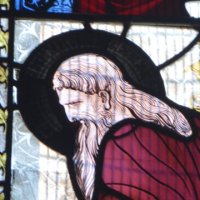 |
The south window of the south transept was inserted in 1862 as a memorial to John Greenham and his wife Elizabeth from their children. It cost £210 (around £130,000 at today's value) and depicts the Last Supper. This window portrays Judas Iscariot with a black halo. The east window was inserted in 1863 showing scenes from the Passion and here too Judas is represented with a black halo - a feature thought to be unique to St John's church.
|
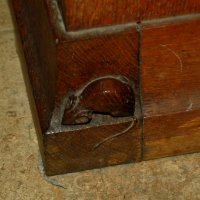 |
The 'Secret'
Church Mice |
![]()
Social Matters
The hundred was headed by a Hundred-Man or Hundred Elder and in the
immediate
post-Conquest
period the
duties of the
Hundred Elder
included
organising,
supplying and
leading the
military forces
of the hundred.
Since in return
for being
granted the use
of a hundred
hides of land,
technically the
'property' of
the king in the
Feudal system,
the men of the
hundred were
bound to supply
one hundred men
for military
service when
required by the
King.
The Hundred
Stone
The 'hundred' was a tenth century Saxon division of the shire for
judicial and
military
purposes. The
geographic area
of the hundred
was the land
required to
sustain
approximately
one hundred
households.The hundred usually took the name of the main town in the area but in
Yeovil it was
called the
Hundred of Stone
in reference to
the local
landmark, the
Hundred Stone,
at the junction
of today's Stone
Lane and Mudford
Road - the
highest point in
Yeovil and its
hinterland. This
was the
traditional
hundred meeting
place, where the
Hundred Court
was held. The
Hundred of Stone
not only
included Yeovil,
but Odcombe,
Brympton,
Preston
Plucknett,
Limington,
Ashington and
Mudford and
covered 10,720
acres (4,340
hectares). The
Hundred of Stone
was one of forty
historical
hundreds in
Somerset.
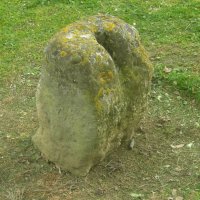
The principal responsibility of the hundred gradually focused on the administration of law and justice within the area. By the twelfth century the Hundred Court would meet in the open around the Hundred Stone each month. The hundred was divided into ten tithings, each containing ten householders and their families. Each tithing was responsible for all that went on in its own small area and those living within the tithing were collectively responsible for each other’s behaviour. Twice a year representatives of each tithing attended the Hundred Court to give a report of the conduct of their members and to admit as new members all males who had reached the age of twelve years.
The administrative importance of hundreds decreased after 1834 although they were still used as a unit for census purposes until 1850. The last recorded meeting of Yeovil's Hundred Court at the Hundred Stone was in 1843.
The Yeovil Riot
of 1349
In Yeovil there had been a longstanding dispute concerning taxes and
other
constraints
regarding market
rights and tolls
and Sunday
trading placed
on the
townspeople of
Yeovil by the
Church. Across
the country
survivors of the
1348 plague, perhaps encouraged by their survival, assumed a more militant
stance than
previously and
in Yeovil
simmering
grievances came
to a head in
November 1349.
Just a couple of
months after the
plague had
ended, their
resentment
against the
Church turned
into a
full-scale riot.
On Sunday 25 November 1349 during a Visitation by Bishop Ralph of
Shrewsbury, the
Bishop of Bath
and Wells, the
anger and
dissatisfaction
of the people of
Yeovil came to a
head and
violence
erupted.
The mob
attacked the
Bishop and his
entourage who
were forced to
retreat within
the church (the
Saxon church,
not today's
building), where
they remained
all night.
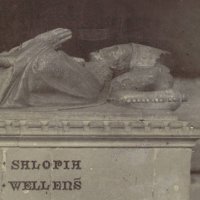
The following morning some of the rioters broke into the church. As one of the priests tried to talk with the mob, their ringleader, Roger de Warmwelle, struck the priest and the mob erupted. Of course, there were dire consequences. The church itself was interdicted by the Pope and the townspeople who had taken part in the riot were excommunicated. Roger de Warmwelle and a number of the other rioters were fined and made to do public penance and suffer humiliation at Yeovil, Bath, Wells, Bristol, Somerton and Glastonbury.
Beating the
Bounds and the
Hound Stone
Beating the bounds was an ancient custom dating back to Anglo-Saxon times
(it was
mentioned in the
laws of Alfred
the Great) in
which a group of
old and young
members of the
community would
walk the
boundaries of
the parish. They
were usually led
by the parish
priest and
church
officials, to
share the
knowledge of
where the
extents of the
parish lay, and
to pray for
protection and
blessings for
the lands of the
parish.
Since there were few, if any, maps in former times it was usual to make a
formal
perambulation of
the parish
boundaries
during Rogation
Week. Some
places on the
outer limits of
the parish might
be marked with
boundary stones,
such as the
Hound Stone in
Thorne Lane,
seen below.
Perambulation means "walking around" and in traditional English law, it is used specifically to mean "determining the bounds of a legal area by walking around it", meaning physically walking around the parish boundaries. In such a way the parish boundaries were verified annually. Also known as 'Beating the Bounds', it was an important custom since knowledge of the boundaries of each parish needed to be handed down to ensure, for instance, that liability to contribute to the repair of the church, or the right to be buried within the churchyard was not disputed.
The
Hound Stone,
an 18th century
boundary marker,
is located on
the northern
side of Thorne
Lane at Thorne
Cross (the
staggered
crossroads of
Western Avenue
and the Thorne
Coffin road).
According to local tradition, the Hound Stone
(now gradually
being enveloped
by a growing
tree) was the former meeting place of the local hunt, hence
the name Hound
Stone, which was
also then
applied to the
district to the
south. This, of
course, is
completely
erroneous since
'Hundestone' was
actually
recorded as the
name of the area
in the Norman
Domesday Book of
1086.
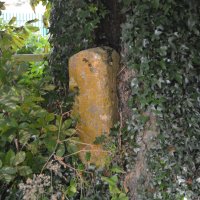
![]()
Yeovil at Work
Evidence
of Early Farming
During the Middle Ages farming was one of the most important livelihoods
in the market
town of Yeovil
and its
immediate
neighbourhood.
Traces of
medieval farming
practices still
exist today in
the form of
lynchets
(from the Old
English
hlinc
meaning 'ridges,
terraces of
sloping ground')
on the lower
slopes of
Summerhouse Hill
- showing as a
series or flight
of stepped
terraces,
visible on the
now grassy
hill-side.
A lynchet, also
known as a strip
lynchet, is a
bank of earth
that builds up
on the downslope
of a field
ploughed over a
long period of
time.
They are
slowly
formed
by
disturbed
soil
slipping
down the
hillside
to
create a
lynchet.
Lynchets
therefore
represent
the
legacy
of
ploughing,
although
not
necessarily
consciously
created
as a
feature,
though
some
initial
construction
may have
been
required
on the
steepest
ground.
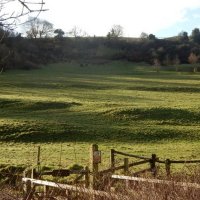
The lynchets are the result of the repeated action of the plough's mould-board turning the loosened soil outwards and downwards; over time forming a level strip or tread for cultivation with a scarp slope (a 'riser') down to the next strip below. Reflecting the practical nature of their creation, they follow the contour lines of the natural slope. The northern flanks of Summerhouse Hill still retain these reminders of Yeovil's medieval farming past.
Minting
your own Money
Following the death of Charles I in 1649 no copper coinage was minted
during the
Commonwealth.
The resulting
paucity of small
coinage was met
by
independently-produced
and completely
unauthorised
coins - actually
trade tokens
- of brass,
latten (a copper
alloy similar to
brass) or
pewter. Most
Yeovil trade
tokens were
issued by
tradesmen in
order to
overcome the
lack of small
change in
general
circulation and
enable trading
activities to
proceed. The
token was, in
effect, a pledge
redeemable in
goods although
not usually for
currency.

These tokens never received official sanction from government but were accepted and circulated quite widely. Even the Portreeve, on behalf of the Borough of Yeovil, minted and issued halfpennies, seen above, during 1668 and into 1669. From 1672, in the reign of Charles II, official farthings and halfpennies were minted again with the consequent demise of trade tokens. The value of a farthing in the 1650s was roughly equivalent to £2 at today's value.
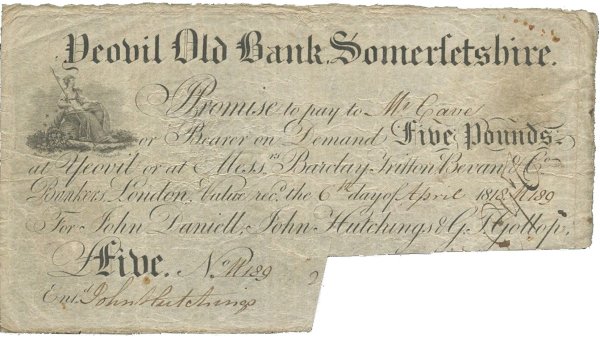
During the end of the eighteenth century a number of private banks were established in Yeovil. Private banks were allowed to issue their own banknotes. Far from being ordinary currency as we are used to today, the £1, £5 and £10 notes issued by these banks were not for use in everyday shopping transactions. For example the £5 banknote of Yeovil Old Bank issued in 1818 illustrated here would have a value of about £335 at today's value.
Dobell
Clockmakers
Robert Dobell
was born in
Wiltshire in
1808. He married
Elizabeth Tucker
at St John's
church in 1830 -
the same year
Pigot's
Directory listed
him as a "Watch
& Clock Maker of
Middle Street".
In the autumn of
1837 Elizabeth
died and in the
spring of the
following year
Robert married
Mary Ann Hardy
at St John's
church.
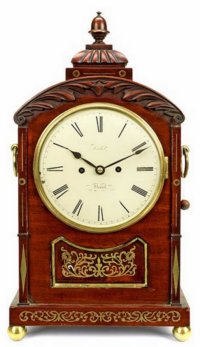 |
Robert
was
listed
as a
'Watch &
Clock
Maker of
Middle
Street'
in the
Somerset
Gazette
Directory
of 1840.
In the
1841
census
he was
listed
as
living
with his
new wife
Mary,
three
children
and a
servant
in
Hendford
on the
corner
of High
Street.
35-year
old
Robert
gave his
occupation
as a
Jeweller.
|
In the 1861 census, 53-year old Robert and 19-year old Frederick, together
with a domestic
servant, were
listed at
Hendford and
both father and
son gave their
occupations as
Jewellers.
Robert Dobell
died in the
spring of 1868
aged 61. His
business was
carried on by
Frederick.
Brickmaking
Yeovil clay was suitable for brickmaking and several brickworks were to be found in the town producing the soft, bright red bricks found everywhere in the older parts of Yeovil. The main Yeovil brickfields, seen below, were located north of Reckleford in the general area of Eastland Road, at this time known as Kiddle's Lane. Early maps show a clay pit from which the raw material was obtained as well as a brick kiln to the northwest of Dampier Street and to the east of Kiddle's Lane.
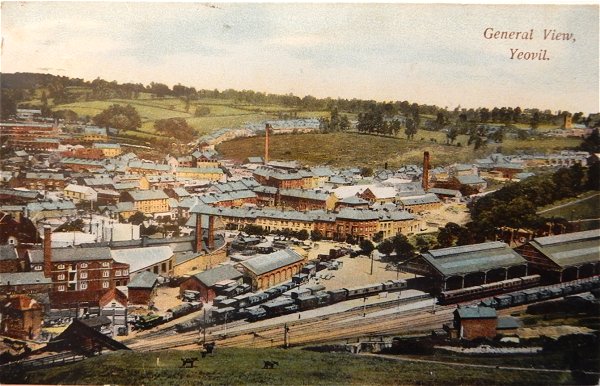
From my
collection
This postcard dates to about 1905 and shows, at centre, the chimney of the Yeovil Brickfields Co Ltd on the southeast corner of Eastland Road with its associated buildings clustered around its base. Running across the centre of the photograph is Station Road with the Alexandra Hotel at right. In the top half of the photo, Eastland Road runs behind the chimney with fields either side!
Extensive brickworks were also to be found at St Michael's Avenue which, indeed, was originally known as Brickyard Lane. The section from Milford Lane to Mudford Road was still called Brickyard Lane on the 1928 Ordnance Survey. There some fourteen other, smaller brickworks in the town such as at New Town, Preston Road and Ilchester Road.
Most
of the Yeovil
brick-making
sites were small
in scale and
didn't last for
long, which
suggests
short-term
investment by
builders and
others to meet
new local
housing needs.
In fact the
majority of
Yeovil's brick
makers were
already in the
building trade.
The Yeovil Motor Car
James Petter’s twin sons, Ernest and Percy, had always been interested in transport and even at the age of twelve Percy, under the guidance of his eldest brother, had "made some hand-propelled velocipedes.... and later used to hire a wood wheeled 'penny farthing' boneshaker. By 1892 Percy and Ernest had designed and produced a self-propelled oil engine and in 1895, together with their inventive engineer, designer and foreman Ben Jacobs (who remained in service with the Petters until he was in his late seventies), they developed a new engine of one horse-power designed specifically to propel a 'horseless carriage'. They produced the first motor car with an internal combustion engine to be made in Britain, using a converted four wheel horse-drawn Hill and Boll phaeton and a 3hp Petter horizontal oil engine. The vehicle was constructed at the Park Road carriage works of Hill and Boll. It had a top speed of twelve miles per hour.
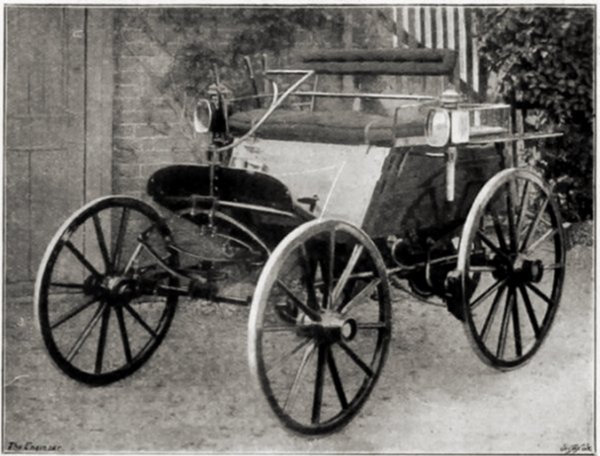
The Yeovil Car - the first motor car with an internal combustion engine to be made in Britain. This photograph appeared in the 3 April 1896 edition of 'The Engineer' magazine, captioned "Petter and Hill & Boll's Oil-Motor Carriage" with an accompanying article and plans.
Believing they had a great opportunity the brothers, with their father,
formed the
Yeovil Motor Car
Co Ltd in 1895
with a thousand
pounds capital
and a factory
was built on the
site of James'
garden in
Reckleford,
later to be
expanded as the
Nautilus Works.
The company was
to make small
two-person motor
carriages,
initially at
their foundry in
Huish / Clarence
Street and then
at Reckleford in
conjunction with
carriage makers
Hill & Boll of
Park Road. In
all,
some twelve
different
'horseless
carriages' were
developed. This
same year the
company was one
of four that
offered
automobiles for
trials at
Chelsea and
their twelfth
model, the
'Yeovil Car',
was exhibited at
the 1897 Motor
Car Exhibition
held at the
Crystal Palace.
Yeovil's Commemorative Medallions
It has long been a tradition for Yeovil schoolchildren to receive a commemorative medallion at the times of the monarch's jubilee or other celebration.

The above medals are, from left to right,
The Diamond Jubilee medallion celebrating Queen Victoria's 60-year reign, inscribed "Presented by the Directors of the Western Gazette and Pullman's News Newspapers Co Ltd. 1897".
A scarce commemorative medallion given to Sunday school children of Yeovil by the then Mayor of Yeovil, Sidney Watts, to commemorate the 1893 marriage of HRH Prince George (1865-1936), later King George V (reigned 1910-1936), to HSH Princess Mary of Teck (1867-1953).
Another scarce commemorative medallion given by Henry Stiby, later Mayor of Yeovil, to school children to commemorate the 1902 coronation of King Edward VII (reigned 1901-1910) and Queen Alexandra (1844-1925).
This commemorative medallion was given by Henry Stiby to younger schoolchildren in 1911 to commemorate the coronation of King George V (reigned 1910-1936).
![]()
Some Lesser-Known Yeovilians
John Perry
Technical
Blacksmith and
Temperance
Hotelier
John Perry was born in 1810 in Somerton and moved to Yeovil around 1839 with his wife Jemima and their first two of five children. They initially lived in Park Street and John worked as a journeyman whitesmith (tinsmith). By 1851 John had moved his family to Hannam's Lane (today's Tabernacle Lane) where he took over Henry Bragg's smithy.
John
regarded
himself
as a
'Technical
Blacksmith'
and
created
intricate
clockwork
mechanisms
as later
described
in a
journal
of 1899
-
"Amongst
local
inventions
the
clockwork
'modles'
of the
late
John
Perry of
Yeovil,
take
high
rank.
They all
worked
by a
penny-in-the-slot
arrangement.
There
were
about a
dozen of
them,
such as
a church
showing
ringers
at work
in the
belfry,
a man at
a pump
pumping
lemonade
into a
glass, a
smith's
workshop,
etc.
They
were
exhibited
at a
working
man's
exhibition
in
London.
First
shown in
Tabernacle
Lane,
Yeovil,
and
afterwards
at fairs
all over
the
country."
Certainly
by 1856
John
Perry
was
running
Perry's
Family &
Commercial
Temperance
Hotel
in
South
Street
and was
hosting
temporary
photographic
portrait
rooms to
visiting
professional
photographers.
The
hotel
was
across
the road
from
Hannam's
Lane and
was
situated
between
the
Globe
and
Crown
and the
Baptist
Chapel.
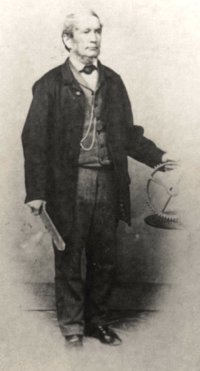
In August 1865
Hanham & Gillett
sold their
ironmongery
establishment in
the Borough to
John Petter and
at this time
John Perry,
having also been
the manager of
Hanham &
Gillett's
workshops for
some 23 years,
set up his own
engineering
business in
South Street in
partnership with
his son.
Doctor William
Fancourt Tomkins
Surgeon of
Magnolia House
and Borough
House
William Fancourt
Tomkins was
born in Yeovil
in 1825, the
eldest of the
seven children
of Yeovil
surgeon
William Tomkins
and Hannah née
Holland. He was
brought up in
the family home
of
Magnolia House
in
Princes Street.
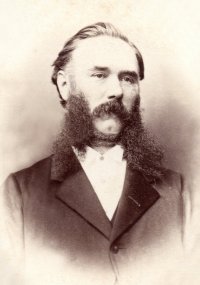 |
William qualified as a Doctor of Medicine and was noted as such in the 17 September 1846 edition of the London Medical Gazette. He was admitted to the Royal College of Surgeons in January 1847. In the 1851 census William Snr gave his occupation as "M.D. London College Consulting Physician" and his eldest son, 26-year old William Fancourt, gave his occupation as a "Practicing Surgeon". On 30 October 1855 at Piddletrenthide, Dorset, William married 34-year old widow Sarah Palmer, formerly Sarah Flower. William and Sarah set up home at Borough House in High Street, which also served as William's medical practice until his retirement around 1890. |
Henry Monk
Headmaster of
Yeovil Charity
School and
Yeovil Grammar
School
Henry Monk was born in 1833 in Harrow Weald, Middlesex, the son of James and Mary Monk. Henry was a student at St Andrews College, Harrow. In May 1859 he was elected to the post of Master of the Yeovil Charity School which marked his move to Yeovil. On 9 January 1860, at the age of 27, Henry married Elizabeth Henrietta Hawkins at Harrow All Saints Church, Harrow Weald. They were to have nine children. In the 1861 census Henry and Elizabeth were living on Sherborne Road. Henry gave his occupation as 'Grammar Schoolmaster' while Elizabeth listed her occupation as 'Superannuated from the War Department'.

A photograph of Monk's school dated 1909. Henry Monk is at right and his daughter Edith at left.
During the 1860s Henry and Elizabeth moved to Hendford Hill where Henry opened his own school. In the 1871 census Henry and Elizabeth and their children were listed at Hendford Hill together with eighteen boarding pupils, a cook and a nursemaid. Henry simply gave his occupation as Schoolmaster. In the 1870s Henry moved his family yet again to 8 Hendford, today known as Flowers House. This was to become famous towards the end of the nineteenth century as Mr Monk's Grammar School.
Henry moved from Hendford to the Chantry in Church Path in 1897 (presumably due to the sharp drop in the number of pupils attending) and the Grammar School in Hendford was put up for sale. By 1901 Henry had moved his family to Ashgrove, Mudford Road. He was listed in the census as a 68-year-old schoolmaster with 67-year-old Elizabeth and three of their children. Henry was still teaching in 1909 at the age of 76, but by 1911 he had retired and was living in Ryme Intrinsica, Dorset, with Elizabeth and their two daughters Edith and Laura.
Frederick Cox
Builder of
Frederick Place
Frederick Place connected Middle Street with Vicarage Street for pedestrian traffic and had houses on both sides until the 1970s. It is now a link from Middle Street to the Quedam shopping centre. Frederick Place was named after Frederick Cox, a local builder, who had a builder's yard there in the latter half of the nineteenth century. Frederick Cox was a Freemason, initiated into the Lodge of Brotherly Love in Yeovil on 14 August 1861. He served as Worshipful Master of the Lodge in 1868 and the photograph below shows him in his Masonic regalia.
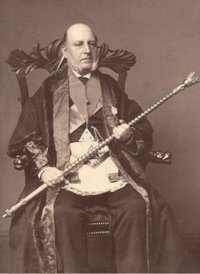 |
Frederick Cox was born in 1825, the son of builder and Town Councillor John Cox and his wife Mary. By 1881 Frederick was married, had seven children, two servants and was still living in Middle Street. He listed his occupation as 'Builder employing 25 hands'. Three local projects built by Frederick Cox were the Fiveways Hospital (1871), the Congregational Church in Princes Street (1877) and the Corporation Baths in Huish (1885). The carved stone head on the arch keystone above the Middle Street entrance to Frederick Place is reputed to be a likeness of Frederick Cox although it clearly isn't and the stone head isn't as old as you might think, dating from when the adjoining Albany Hotel was rebuilt in 1873. |
Frances Connelly
Yeovil's first Lady Voter
Women were not
allowed to vote
in Great Britain
until the 1832
Reform Act and
the 1835
Municipal
Corporations
Act. However it
would not be
until 1872, with
the formation of
the National
Society for
Women's Suffrage
and later the
more influential
National Union
of Women's
Suffrage
Societies that
the struggle for
women's voting
rights became a
national
movement. By
1906 the
movement was
beginning to
shift opinion in
favour of
women's suffrage
and it was then
that the
militant
campaign began
with the
formation of the
Women's Social
and Political
Union. In 1918,
a coalition
government
passed the
Representation
of the People
Act 1918,
enfranchising
women over the
age of 30 who
met minimum
property
qualifications.
Ten years later,
in 1928, the
Conservative
government
passed the
Representation
of the People
(Equal
Franchise) Act
giving the vote
to all women
over the age of
21.
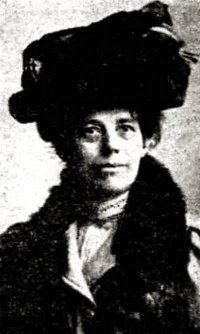 |
However, the first female to vote in Yeovil was Mrs Frances Connelly of Reckleford who claimed, and cast her vote, in November 1911. The following report is from the Taunton Courier & Western Advertiser's edition of 29 November 1911 "The election will be remembered for the first time in the history of the constituency a woman claimed and was allowed to exercise the Parliamentary franchise. At the very moment a Suffragist's car was touring Yeovil displaying to an amused crowd the legend "Mothers want votes", a lady was putting her cross against the name of Mr Aubrey Herbert - at least she is supposed to be on the Unionist side - at the Town Hall. Mrs Frances Connelly, of Reckleford, Yeovil, discovered that her name was on the register and claimed to vote. |
The presiding officer (Mr WW Henley) demurred. The lady consulted the Conservative agent, Mr Harold Fletcher, who, having in turn discussed the situation with Mr WT Snell, barrister of the Western Circuit, who happened to be assisting in the Committee room. He interviewed the presiding officer and represented to him that the lady's name being on the register he had no alternative but to allow her to vote, the only conditions being that she was the person described on the register and had not previously voted in the election. The point was carried, and Mrs Connelly voted. What is more her vote was recorded in the ordinary way - not upon a 'tendered' paper - and was counted with the others."
Frances Connelly
died in Yeovil
in 1917, aged
48.
Fred 'Johnny' Hayward
Holder of a record that will remain unbeaten
Fred Hayward,
known as Johnny,
was born in
Yeovil in the
spring of 1887.
He was the
youngest of the
seven children
of glove cutter
William H
Hayward and his
wife Mary Ann
née Tutchings.
When he was
little the
family lived in
Wellington
Street, moving
to
Huish by the
time 14-year old
Fred/Johnny was
working as a
solicitor's
clerk. His
career in law
was short lived
and most of his
working life was
spent as a glove
cutter like his
father. In
August 1912 he
married Mabel
Alice Harbour.
They set up home
in
Everton Road
and were to have
seven daughters
and two sons.
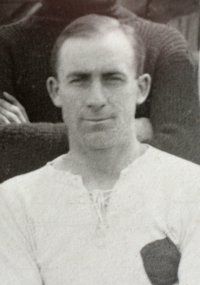 |
Johnny's passion was football and from April 1907 he played for his local team, Yeovil Town Football Club. Johnny played for the club until 1927, usually positioned as centre forward and for many years captaining the team. His football career was interrupted by war service when he enlisted in the Machine Gun Corps during May 1916. Nevertheless, despite this wartime interruption in his football career, Johnny Hayward holds the record for being the highest goal scorer for a single club in the history of English football. During his career he achieved an extraordinary number of goals - at least 548 (some data on matches in those days was incomplete) and claims a record that will surely never be beaten. |
At his peak, he
netted 52 goals
in just 33 games
during the
1919-20 season
and 50 more in
the 1921-22
season.
Fred 'Johnny'
Hayward retired
from football in
1927 and died in
1958 aged 71.
![]()
Dark Deeds
A Few 'Snippets'
We begin with
some crimes that
would, perhaps,
today be
considered less
than heinous yet
occasionally
were accorded
the ultimate
punishment. We
start with some
snippets from
the past, in
date order.
"To Ivelchester
Gaol: William
Scott and
Margery Chapeley,
his mother, for
burglary; Scott
is twenty-three
years of age,
about five feet
high, was born
at Yeovil."
Police
Gazette, 29 July
1774.
"Wednesday
executed at
Ilchester, Alex.
Pearce, aged 19,
for setting fire
to his master's
[Thomas Garland
of the
Greyhound Inn,
South Street]
house and
stables at
Yeovil....
Alexander Pearce
was born at
Sherborne, and
apprenticed to a
tailor, but
losing a finger
by accident, was
obliged to
decline that
business, and
turned labourer.
Many strong
circumstances
appeared on his
trial, which
plainly proved
his guilt,
though he
declared his
innocence to the
last of ever
having any
knowledge of the
fact for which
he suffered. He
appeared very
insensible of
his approaching
fate, and
declared that he
had never robbed
or intentionally
injured any
one."
Bath
Chronicle &
Weekly Gazette,
2 September 1790.
"Gibraltar, March 6 1768. A private Soldier of the 19th
Regiment under
my Command here,
has confessed
himself a
Murderer,
enclosed I have
taken the
Liberty to
transmit to you
a Copy of his
Confession, viz.
"I Nathaniel
Jones, Soldier
in the 19th
Regiment, in
Chapel Norton's
Company, do
confess, that
about the Month
of April, 1765,
I murdered a
Woman dressed in
a Stamped Cotton
Jacket, and a
Check Apron (the
Colour of the
Petticoat I
forgot) near
Yeovil in
Somersetshire,
in the cross
Country Road
leading from
Beaminster to
Yeovil; and then
having taken
what Money I
could find upon
her, threw her
into a Marl Pit
near thereto."
Derby Mercury,
22 April 1768.
"On Thursday evening a quarrel took place at the
Penn Mill Inn
[not today’s Pen
Mill Hotel, but
a cider house on
the Sherborne
side of the
railway line],
near Yeovil,
between a
journeyman
glover, named
Allen, and an
itinerant dealer
in corks, named
Smith, in
consequence of
which the former
challenged the
latter to a
fight. Smith,
who was in some
degree
intoxicated, was
at first
unwilling to
comply; but,
provoked by his
antagonist, and
urged on by his
wife, he at
length entered
into the contest
and in the
second round
received a blow
to the neck,
which, in the
state of
excitement
arising from
liquor and the
anger he was in
at the moment,
caused instant
death. A
coroner’s
inquest was held
on the body on
Friday evening,
by Mr Uphill,
when a verdict
of
'Manslaughter'
was returned
against Allen,
who has
absconded."
Western Flying
Post, 9 October
1828.
"A banditti of turnip stealers, forty in number, attacked
and cruelly beat
the four sons of
Mr Symes, a
farmer, of
Yeovil,
Somerset, who,
with five
others, were
stationed to
protect a turnip
field from their
depredations....
Although two of
the farmer's
party were so
much beaten that
their lives are
in danger, they
succeeded in
repelling the
plunderers, and
securing three
of them, who are
committed to
Ilchester gaol
for trial."
Stamford
Mercury, 12
December 1916
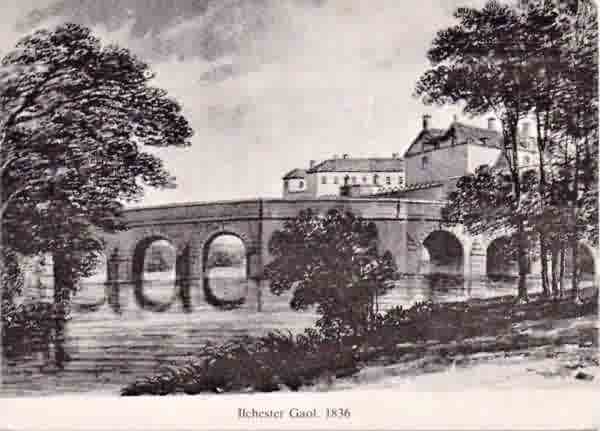
From my
collection
A contemporary sketch of Ilchester Gaol, the temporary residence of many a Yeovilian.
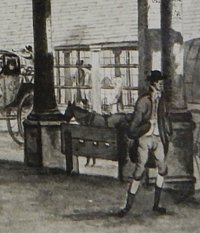 |
Yeovil's Stocks |
For
centuries
Yeovil, like
most towns,
possessed a set
of stocks. These
were situated
between the
pillars of the
Market House
-
essentially a
roof supported
by columns that
covered the
market traders'
stalls -
that stood in
the middle of
the
Borough.
Yeovil’s stocks
were last
occupied on
Thursday 24
September 1846
by a man named
Stoodley. He was
found guilty of
being drunk on a
Sunday afternoon
and was confined
in the stocks
for three hours.
Death of a Mendicant
James Beare
became one of
Yeovil's early
law enforcement
officials, known
in the 1830s as
a Watchman, and
was based at the
Tolle Hall
in
the Borough.
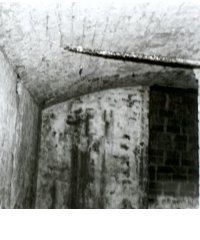 The
town's
Watch-House or
lock-up (seen
at left) was in
cellars of the
building where they remain today,
roughly beneath
the
War
Memorial.
On 8 January 1838 a drunken mendicant, or beggar,
42-year-old
Isaac Justins, was thrown in the cells
but left there
without food,
water or heat
for two days,
resulting in his
death.
Consequently
James Beare, and
co-Watchman
George Hill,
were charged and
tried for
manslaughter.
The
town's
Watch-House or
lock-up (seen
at left) was in
cellars of the
building where they remain today,
roughly beneath
the
War
Memorial.
On 8 January 1838 a drunken mendicant, or beggar,
42-year-old
Isaac Justins, was thrown in the cells
but left there
without food,
water or heat
for two days,
resulting in his
death.
Consequently
James Beare, and
co-Watchman
George Hill,
were charged and
tried for
manslaughter.
It
must be presumed
that the case
against James
Beare was
ultimately
dismissed
although he
almost certainly
lost his job as
a Watchman
since,
immediately
after the case,
he became a
beerhouse keeper
at the fledgling
Beehive Inn
in
Huish.
Murder of Constable Penny
Just before midnight, during the evening of Saturday 18 January 1862, Police Constable William Hubbard of the Somerset Constabulary was on duty on Hendford Hill when, without warning, he was assaulted by a gang of navvies who had been employed on the railway. Hubbard then met Constable William Penny, and told him what had happened.
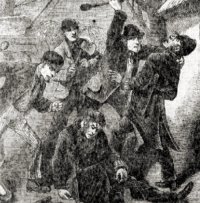 From the Police Gazette |
The rest of the navvies then gathered round and, being greatly outnumbered, Hubbard and Penny let the gang move on along Hendford Hill. The two Constables then met their Sergeant Keats and explained to him what had occurred. Together they returned to the gang of navvies, following them along the Dorchester Road, close to the Red House public house. A fight ensued and PC Penny was knocked to the ground, where the navvies viciously kicked him. |
Constable Penny was then taken into the Red House, where he was attended by doctors. William Penny never rallied properly and died the following Saturday. Three of the navvies were later tried for manslaughter; two were acquitted and the third received a sentence of four years.
Robert Slade Colmer
Sadly, space precludes an in-depth study of a man who was probably one of the worst Yeovilians of all time - Robert Slade Colmer. He was a herbalist and… a paedophile (he got off on that one), a back-street abortionist (actually a Middle Street abortionist), he was tried for manslaughter, made a bankrupt and he was an adulterer. Oh yes - he was also a murderer and the father of Ptolemy Colmer who, despite his father, became a physician, surgeon and Mayor of Yeovil .
On 9 December 1844 at Taunton winter assizes Robert, aged 27 was tried on the charge of "Carnally abusing a girl between the age of 11 and 12 years". For lack of evidence (and the court clearly didn’t believe the testimony of a child) he was found not guilty.
In October 1863, an inquest was opened before Dr Wybrants, at the Castle Inn, on the body of Elizabeth Fox, a young woman who had been living as a servant at Rimpton. It appeared that she was pregnant and that she went to Colmer for medical advice. She remained there some days, and death is said to have taken place early on Sunday morning. On post-mortem examination, a frightful laceration of the womb was found. After a lengthy inquest the jury bought in a verdict of manslaughter against Robert Slade Colmer. He was indicted for slaying Elizabeth Fox and was also indicted for misdemeanor or, in other words, concealment of birth. The evidence at Colmer's trial was all of a circumstantial nature and ultimately the jury returned a verdict of 'Not Guilty'.
In March 1880 Robert and his wife Jane, also a 'herbalist', were visited by a widow, Mary Budge of Crewkerne. Mary was pregnant by her young lodger and, in short, the Colmers performed an abortion after which Mary returned to Crewkerne on the train with her lover. She died in agony during that night. Robert and Jane Colmer were both tried at the Old Bailey, found guilty and convicted for the willful murder of Mary Budge at Yeovil, by illegal operation. (For full details of the trial, click here). On 3 August 1880 both Robert and Jane were sentenced to death. On 19 August 1880 the Home Office commuted the sentence of death on both Robert and Jane to one of penal servitude for life. In the 1881 census Robert Colmer, aged 66, was listed as a convicted felon in Pentonville prison, London. Jane was serving her sentence at Millbank prison, London.
Robert
Slade Colmer
died in prison
at the age of 73
in the winter of
1889. Jane,
however, was
somewhat luckier
than her husband
and was released
from prison. In
the 1891 census
she was 'living
on her own
means' in
Peter
Street with her
herbalist
daughter,
Cleopatra. Jane
died later that
year aged 76.